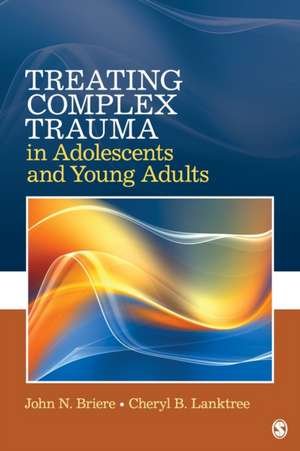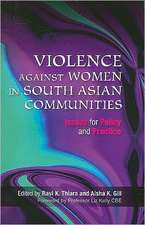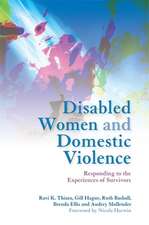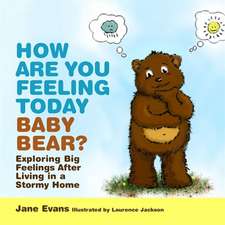Treating Complex Trauma in Adolescents and Young Adults
Autor John N. Briere, Cheryl B. Lanktreeen Limba Engleză Paperback – 2 noi 2011
Preț: 718.61 lei
Preț vechi: 876.35 lei
-18% Nou
Puncte Express: 1078
Preț estimativ în valută:
137.51€ • 143.93$ • 114.45£
137.51€ • 143.93$ • 114.45£
Carte tipărită la comandă
Livrare economică 31 martie-14 aprilie
Preluare comenzi: 021 569.72.76
Specificații
ISBN-13: 9781412981446
ISBN-10: 1412981441
Pagini: 272
Dimensiuni: 152 x 229 x 17 mm
Greutate: 0.34 kg
Ediția:1
Editura: SAGE Publications
Colecția Sage Publications, Inc
Locul publicării:Thousand Oaks, United States
ISBN-10: 1412981441
Pagini: 272
Dimensiuni: 152 x 229 x 17 mm
Greutate: 0.34 kg
Ediția:1
Editura: SAGE Publications
Colecția Sage Publications, Inc
Locul publicării:Thousand Oaks, United States
Recenzii
"This is a very concise, well-structured and comprehensive guide for the assessment and treatment of complex trauma in adolescents. It provides thorough descriptions of the multiple levels of interventions that are needed in order to facilitate therapeutic progress and re-establish healthy development in adolescents with histories of early traumatization. In addition, the model provides some practical tools that facilitate the implementation of appropriate strategies at different stages of treatment."
"The treatment model implemented in this text is excellent! This model is based upon evidence- based principles, and addresses the unique developmental and treatment needs of adolescents who are survivors of multiple traumatic experiences. No other book in the literature comes close to this thoroughly addressing the multiple treatment needs of multi-traumatized adolescents. Complex trauma and complex trauma as applied to adolescents is not this thoroughly addressed anywhere in the literature. This book is essential reading for any practitioner."
"Drs. Briere and Lanktree have admirably succeeded in describing a truly integrative approach to psychotherapy for children and adolescents whose complex trauma histories and correspondingly complex symptoms present clinicians with a formidable challenge. This book provides a uniquely comprehensive guide to treatment planning, assessment, and therapy strategies that should be required reading for every therapist working with these youths."
"This important text offers a comprehensive and practical treatment model for complex trauma, Integrative Treatment of Trauma for Adolescents (ITCT-A), for an age group that has not received adequate attention.The model is based on the most current research and treatment recommendations and expands upon the state of the art. Drs. Briere and Lanktree are to be congratulated for developing this highly integrative model and for providing therapists with such a clear description of its use and applications. Treating Complex Trauma in Adolescents and Young Adults is destined to be a classic."
"This innovative book provides clinicians with an immediately useful blueprint for negotiating challenging clinical issues when working with teens and youth with histories of complex trauma. The combined clinical experience of these two seasoned researchers/clinicians is evident as they emphasize a comprehensive assessment, a customized approach, and the integration of both structure and flexibility. Of particular value are assessment-treatment tools included in the text that encourage a detailed assessment of the client's current functioning, along with clear guidelines for transitioning from problems to interventions. This structured approach also promotes establishing a strong therapy relationship that attends to culture, development, and gender. This model provides "how to" approaches every step of the way while requiring clinicians to utilize optimal judgement, sensitivity, and investment in their work with traumautized youngsters. I highly recommend this evidence-informed, clinically-sound, and inspired book."
"Drs. Briere and Lanktree's keenly insightful approach provides the therapist a window into the intricacies and challenges confronting youth from different social and ethno/cultural communities. It offers innovative, culturally sensitive strategies for assessing and treating high-risk, traumatized youths, and embodies the single most important goal of our profession's collective efforts: taking our findings from clinical and research settings to communities - "bench to the trench," striving to ensure that no child is, in fact, left behind."
"Over past two decades, scientists, mental health practitioners and service providers have developed considerable interest in understanding the phenomenology of complex trauma in children, adolescents and adults who have suffered repeated and severe exposures to a wide-range of childhood traumatic experiences, including physical, sexual and emotional abuse and domestic violence. With this interest has emerged a growing body of research and information on the nature, assessment, and treatment of complex trauma that the authors of Treating Complex Trauma in Adolescents and Young Adults have integrated into a comprehensive and compelling, evidence-informed and assessment-driven treatment model and approach: Integrative Treatment of Complex Trauma for Adolescents (ITCT-A). Addressing a major gap in the trauma-treatment literature, this exceptionally well-written volume is an indispensable resource for psychologists, psychiatrists, social workers, psychiatric nurse practitioners, and therapists working with severely traumatized adolescents and their caregivers across the child-serving systems that provide care, including private practice, mental health clinics, family medicine and pediatrics, child welfare, juvenile justice, schools, and substance abuse treatment."
"The treatment model implemented in this text is excellent! This model is based upon evidence- based principles, and addresses the unique developmental and treatment needs of adolescents who are survivors of multiple traumatic experiences. No other book in the literature comes close to this thoroughly addressing the multiple treatment needs of multi-traumatized adolescents. Complex trauma and complex trauma as applied to adolescents is not this thoroughly addressed anywhere in the literature. This book is essential reading for any practitioner."
"Drs. Briere and Lanktree have admirably succeeded in describing a truly integrative approach to psychotherapy for children and adolescents whose complex trauma histories and correspondingly complex symptoms present clinicians with a formidable challenge. This book provides a uniquely comprehensive guide to treatment planning, assessment, and therapy strategies that should be required reading for every therapist working with these youths."
"This important text offers a comprehensive and practical treatment model for complex trauma, Integrative Treatment of Trauma for Adolescents (ITCT-A), for an age group that has not received adequate attention.The model is based on the most current research and treatment recommendations and expands upon the state of the art. Drs. Briere and Lanktree are to be congratulated for developing this highly integrative model and for providing therapists with such a clear description of its use and applications. Treating Complex Trauma in Adolescents and Young Adults is destined to be a classic."
"This innovative book provides clinicians with an immediately useful blueprint for negotiating challenging clinical issues when working with teens and youth with histories of complex trauma. The combined clinical experience of these two seasoned researchers/clinicians is evident as they emphasize a comprehensive assessment, a customized approach, and the integration of both structure and flexibility. Of particular value are assessment-treatment tools included in the text that encourage a detailed assessment of the client's current functioning, along with clear guidelines for transitioning from problems to interventions. This structured approach also promotes establishing a strong therapy relationship that attends to culture, development, and gender. This model provides "how to" approaches every step of the way while requiring clinicians to utilize optimal judgement, sensitivity, and investment in their work with traumautized youngsters. I highly recommend this evidence-informed, clinically-sound, and inspired book."
"Drs. Briere and Lanktree's keenly insightful approach provides the therapist a window into the intricacies and challenges confronting youth from different social and ethno/cultural communities. It offers innovative, culturally sensitive strategies for assessing and treating high-risk, traumatized youths, and embodies the single most important goal of our profession's collective efforts: taking our findings from clinical and research settings to communities - "bench to the trench," striving to ensure that no child is, in fact, left behind."
"Over past two decades, scientists, mental health practitioners and service providers have developed considerable interest in understanding the phenomenology of complex trauma in children, adolescents and adults who have suffered repeated and severe exposures to a wide-range of childhood traumatic experiences, including physical, sexual and emotional abuse and domestic violence. With this interest has emerged a growing body of research and information on the nature, assessment, and treatment of complex trauma that the authors of Treating Complex Trauma in Adolescents and Young Adults have integrated into a comprehensive and compelling, evidence-informed and assessment-driven treatment model and approach: Integrative Treatment of Complex Trauma for Adolescents (ITCT-A). Addressing a major gap in the trauma-treatment literature, this exceptionally well-written volume is an indispensable resource for psychologists, psychiatrists, social workers, psychiatric nurse practitioners, and therapists working with severely traumatized adolescents and their caregivers across the child-serving systems that provide care, including private practice, mental health clinics, family medicine and pediatrics, child welfare, juvenile justice, schools, and substance abuse treatment."
Cuprins
Acknowledgements
1. Introduction
Section I: Complex Trauma Outcomes and Assessment
2. Complex Trauma in Adolescence and Young Adulthood
3. Assessment
4. Completing and Using the Assessment-Treatment Flowchart for Adolescents (ATF-A)
Section II: Overview of Treatment
5. Central Aspects of ITCT-A
6. From Assessment to Intervention: The Problems-to-Components Grid (PCG)
7. Sequence and Session-Level Structure of ITCT-A
Section III: Treatment Components
8. Relationship Building and Support
9. Safety Interventions
10. Psychoeducation
11. Distress Reduction and Affect Regulation Training
12. Cognitive Processing
13. Trigger Identification and Intervention
14. Titrated Exposure
15. Relational Processing
16. Interventions for Identity Issues
17. Family Therapy
18. Interventions With Caretakers
19. Group Sessions
20. Three Case Examples
21. Treatment Outcome Results
22. Summary
References
Section IV: Appendices
Appendix I: Intitial Trauma Review- Adolescent Version (ITR-A)
Appendix II: ATF-A Assessment Locator
Appendix III: Assessment- Treatment Flowchart: Adolescent Version (ATF-A)
Appendix IV: Problems-to-Components Grid (PCG)
Appendix V: Written Homework About My Trauma
Appendix VI: What Triggers Me? (The Trigger Grid)
Appendix VII: Outlines for Two ITCT-A Therapy Groups
1. Introduction
Section I: Complex Trauma Outcomes and Assessment
2. Complex Trauma in Adolescence and Young Adulthood
3. Assessment
4. Completing and Using the Assessment-Treatment Flowchart for Adolescents (ATF-A)
Section II: Overview of Treatment
5. Central Aspects of ITCT-A
6. From Assessment to Intervention: The Problems-to-Components Grid (PCG)
7. Sequence and Session-Level Structure of ITCT-A
Section III: Treatment Components
8. Relationship Building and Support
9. Safety Interventions
10. Psychoeducation
11. Distress Reduction and Affect Regulation Training
12. Cognitive Processing
13. Trigger Identification and Intervention
14. Titrated Exposure
15. Relational Processing
16. Interventions for Identity Issues
17. Family Therapy
18. Interventions With Caretakers
19. Group Sessions
20. Three Case Examples
21. Treatment Outcome Results
22. Summary
References
Section IV: Appendices
Appendix I: Intitial Trauma Review- Adolescent Version (ITR-A)
Appendix II: ATF-A Assessment Locator
Appendix III: Assessment- Treatment Flowchart: Adolescent Version (ATF-A)
Appendix IV: Problems-to-Components Grid (PCG)
Appendix V: Written Homework About My Trauma
Appendix VI: What Triggers Me? (The Trigger Grid)
Appendix VII: Outlines for Two ITCT-A Therapy Groups
Notă biografică
Descriere
A reader friendly guide to treating traumatized adolescents full of case studies and handouts for training.












